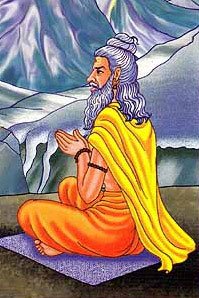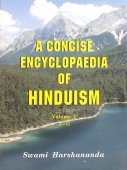Naimisharanya, Naimiṣāraṇya, Naimisha-aranya: 8 definitions
Introduction:
Naimisharanya means something in Hinduism, Sanskrit. If you want to know the exact meaning, history, etymology or English translation of this term then check out the descriptions on this page. Add your comment or reference to a book if you want to contribute to this summary article.
The Sanskrit term Naimiṣāraṇya can be transliterated into English as Naimisaranya or Naimisharanya, using the IAST transliteration scheme (?).
In Hinduism
Purana and Itihasa (epic history)
Source: Cologne Digital Sanskrit Dictionaries: The Purana IndexNaimiṣāraṇya (नैमिषारण्य).—A Kṣetra and forest; a tīrtha where Goddess Lingadhāriṇī is enshrined;1 best in Kṛtayuga;2 sacred to the Piṭrs; here the spokes of Haricakra (Dharmacakra, Vāyu-purāṇa.) fell to pieces; here is the image of Viṣṇu in Vārāha form;3 the sage Pipplāda living there was questioned by Yudhiṣṭhira about aṅgārakavrata;4 the forest where the seers performed sacrifices.^5
- 1) Matsya-purāṇa 1. 4; 13. 26.
- 2) Ib. 106. 57; 109. 3; 110. 1; 180. 55; 246. 93.
- 3) Ib. 22. 12, 14; Vāyu-purāṇa 1. 15.
- 4) Matsya-purāṇa 72, 2, Brahmāṇḍa-purāṇa I. 2. 8; Vāyu-purāṇa 2. 8; 21. 1; 23. 206; 77. 93; 108. 40 and 42.
Naimisaranya refers to one of the 108 divyadesas according to Priyavaccan Pillai’s compendium of the Ramayana based on the Nalayirativviyappirapantam.—Naimisaranya is the mythical abode of Rsis and Seers where they meet to discuss or recite puranic discourses and lectures. The venue is on the Kolkata-Dehradun Railway, near Sitapur. Gomukhi (Goamdai) River flows nearby.
Source: Shodhganga: The saurapurana - a critical studyNaimiṣāraṇya (नैमिषारण्य) or simply Naimiṣā is the name of a forest and one of the various Tīrthas (holy places) mentioned in the 10th century Saurapurāṇa: one of the various Upapurāṇas depicting Śaivism.—In the very first chapter of the Saurapurāṇa the author designates Naimiṣā as the best of the tīrthas, best of the kṣetras as well, where there is the regular abode of the sages. The sages Saunaka and others who were the devotees of Śiva performed a long sacrifice in the Naimiṣāraṇya in order to please Śiva. Sūta Romaharśaṇa arrived there to visit the sages and the sages requested Sūta to narrate the Saura-purāṇa.

The Purana (पुराण, purāṇas) refers to Sanskrit literature preserving ancient India’s vast cultural history, including historical legends, religious ceremonies, various arts and sciences. The eighteen mahapuranas total over 400,000 shlokas (metrical couplets) and date to at least several centuries BCE.
General definition (in Hinduism)
Source: WikiPedia: HinduismNaimiṣāraṇya (नैमिषारण्य): Naimiṣāraṇya (Naimisha Forest) was an ancient forest mentioned in the epic Mahabharata. It lay on the banks of the Gomati River (in Uttar Pradesh). The whole narration of Mahabharata took place at Naimisha forests, during a conclave of sages headed by sage Saunaka.
Languages of India and abroad
Sanskrit dictionary
Source: Cologne Digital Sanskrit Dictionaries: Shabda-Sagara Sanskrit-English DictionaryNaimiṣāraṇya (नैमिषारण्य).—n.
(-ṇyaṃ) A wood celebrated as the residence of the Rishis, to whom Sauti related the Mahabharat. E. nimiṣa a twinkling of an eye, in which the sage Gauramukha destroyed a sort of Asuras, and aṇ aff. and araṇya a forest.
Source: Cologne Digital Sanskrit Dictionaries: Cappeller Sanskrit-English DictionaryNaimiṣāraṇya (नैमिषारण्य).—[neuter] = [preceding] [neuter]
Source: Cologne Digital Sanskrit Dictionaries: Monier-Williams Sanskrit-English DictionaryNaimiṣāraṇya (नैमिषारण्य):—[=nai-miṣāraṇya] [from nai-miṣa > nai] n. the N° w°, [Monier-Williams’ Sanskrit-English Dictionary]
Source: Cologne Digital Sanskrit Dictionaries: Yates Sanskrit-English DictionaryNaimiṣāraṇya (नैमिषारण्य):—[naimiṣā-raṇya] (ṇyaṃ) 1. n. A sacred wood.
Sanskrit, also spelled संस्कृतम् (saṃskṛtam), is an ancient language of India commonly seen as the grandmother of the Indo-European language family (even English!). Closely allied with Prakrit and Pali, Sanskrit is more exhaustive in both grammar and terms and has the most extensive collection of literature in the world, greatly surpassing its sister-languages Greek and Latin.
See also (Relevant definitions)
Partial matches: Naimisha, Ranya, Aranya.
Starts with: Naimisharanyamahatmya, Naimisharanyavasin rama.
Full-text: Naimisha, Kalakoti, Naimica, Utpalini, Sutagosvami, Shaunaka, Naimishakunja, Nagapura, Padmanabha, Naimisheya, Naimicaranyam, Naimicaraniyam, Ugrashravas, Kekaralohita, Drishadvati, Brahmavaivartapurana, Shunaka.
Relevant text
Search found 26 books and stories containing Naimisharanya, Naimiṣāraṇya, Naimisha-aranya, Naimiṣa-araṇya, Naimisa-aranya, Naimisaranya, Naimisha-ranya, Naimiṣā-raṇya, Naimisa-ranya; (plurals include: Naimisharanyas, Naimiṣāraṇyas, aranyas, araṇyas, Naimisaranyas, ranyas, raṇyas). You can also click to the full overview containing English textual excerpts. Below are direct links for the most relevant articles:
The Brihaddharma Purana (abridged) (by Syama Charan Banerji)
Chapter 13 - On the sanctity of the Naimisharanya forest
Haribhakti-sudhodaya (by Tridandi Sri Bhakti Prajnan Yati Maharaj)
Garga Samhita (English) (by Danavir Goswami)
Verse 8.13.57 < [Chapter 13 - A Thousand Names of Lord Balarāma]
Verse 6.15.8 < [Chapter 15 - The Glories of Nṛga-kūpa and Gopī-bhūmi]
Verse 1.1.4 < [Chapter 1 - Description of Śrī-Kṛṣṇa’s Glories]
Puranic encyclopaedia (by Vettam Mani)
Related products
